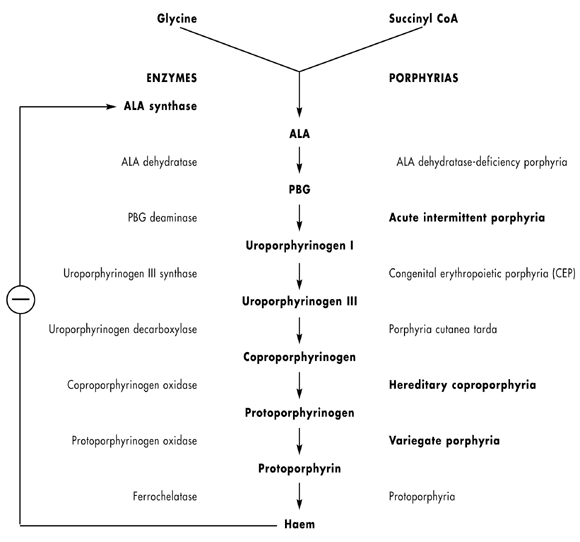Contents
1. What are porphyrias and how do they differ?
2. Why are they called porphyrias?
3. Why are porphyrins important?
4. Why do porphyrins and precursors cause illness?
Acknowledgements
This information is provided for patients and their families with any of the different types of porphyria. It has been written and reviewed by porphyria specialists and patient support groups in Europe.
This work has been co-funded by the European Commission through its Publich Health and Consumer Protection Directorate (DG SANCO), PHEA programme.
1. What are porphyrias and how do they differ?
Altogether there are seven main types of porphyria which are usually classified by what type of illness they cause;
- There are four “acute” porphyrias: acute intermittent porphyria (AIP), variegate porphyria (VP) and hereditary coproporphyria (HC) and a very rare porphyria called ALA dehydratase deficiency porphyria. They are called acute because they usually cause sudden attacks of severe stomach pain that last for several days. VP and HC may also cause skin symptoms.
- The other porphyrias, porphyria cutanea tarda (PCT), erythropoietic protoporphyria (EPP) and the rare congenital erythropoietic porphyria (CEP) (also known as Günther’s disease) affect mainly the skin and do not cause acute symptoms in other organs.
The porphyrias may also be classified as hepatic or erythropoietic depending on the organ where the porphyrins accumulate, the liver for the hepatic porphyrias (AIP, HC, VP and PCT), the bone marrow for the erythropoietic porphyrias.
2. Why are they called porphyrias?
They are called porphyrias because they cause accumulation of chemicals called porphyrins (purple-red pigments named from the Greek for purple) or the simpler chemicals, often called “precursors” (5-aminolaevulinic acid and porphobilinogen, which are often shortened to ALA and PBG) that are used up by the body to make porphyrins.
3. Why are porphyrins important?
Porphyrins are important in the body because they combine with iron to form haem, a red pigment, which, after combining with proteins to form haemoproteins, has the vital function of enabling the body's cells to use oxygen. Haemoglobin, the pigment of red blood cells, is the best known haemoprotein. In other cells, haemoproteins are essential for respiration and many other functions including, particularly in the liver, the transformation of many drugs and chemicals into biologically active or inactive substances.
4. Why do porphyrins and precursors cause illness?
All the porphyrias are due to a specific enzyme(1) defect along the haem biosynthetic pathway (see diagram below).
The acute porphyrias are metabolic disorders that affect biochemical processes mainly in the liver. Accumulation of the simpler ‘precursor’ chemicals in the liver leads to acute attacks of porphyria. They do not cause blood disease or acute liver disease.
When porphyrins accumulate in the skin, they are able to absorb the energy from sunlight. This energy is only kept for a short time and when it is lost again by the porphyrin the energy causes damage to the underlying layers of the skin.

ALA = delta-aminolevulinic acid; PBG = porphobilinogen
1. Enzyme : in our cells the enzymes are the "biological workers" that make all the biochemical processes possible
If you are suspected of having a porphyria, it is important for you to find out which type of porphyria you have because the inherited abnormality and symptoms are different in each one. Once the type of porphyria has been identified you will be able to find out more by selecting the specific patient information leaflet below:
- CONGENITAL ERYTHROPOIETIC PORPHYRIA
- ERYTHROPOIETIC PROTOPORPHYRIAS (EPP & XLP)
